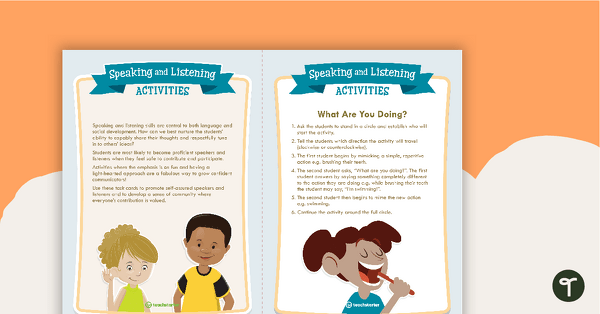Listening Skills Teaching Resources
Help students build good listening skills with printable and digital activities, games and more created by teachers for teachers just like you!
This collection of ELA resources was designed to help students become effective listeners to enhance their comprehension abilities and retain information more effectively throughout their educational journey.
From directed drawing challenges to true or false activities, this collection is packed with resources for elementary school teachers to build their students' overall communication abilities.
What Are Listening Skills? A Kid-Friendly Definition
Whether you're introducing the concept of listening skills for the first time in the classroom, or you're re-visiting them in the first few weeks of the new school year, a definition that kids can understand may come in handy. Here's one from our teacher team!
Listening skills are the abilities we use to pay attention to what others are saying, understand their words and respond in the right way.
Examples of Good Listening Skills for Kids
Do you need some specific examples of good listening skills that your students will find relatable? We've got those for you too!
- Staying Focused — Students can practice paying attention to the speaker and not moving on to another task.
- Taking Turns — Students should learn to wait for their turn to speak and not interrupt the teacher or classmates.
- Showing empathy — Listening attentively and demonstrating understanding and compassion towards others isn't just a listening skill. It's part of social awareness too!
- Understanding Details — Listening skills tie directly into comprehension skills and can be seen when students are able to show they grasped specific information and important details from what was said.
- Asking Questions — When students speak up to seek clarification or get additional information, it's a sign that they are listening and following along.
What Is Active Listening?
Have you heard the term active listening thrown about? It's a concept that was once popular in elementary schools as it focused on kids being "active" in the act of listening — making eye contact with the speaker, sitting still and providing feedback to the speaker by nodding or responding verbally to show they're being attentive.
However, with more and more neurodiverse students attending school who may not be able to (or find it uncomfortable to) make eye contact or stay still while someone is speaking, there's an increased move toward simply suggesting kids engage in full-body listening.
Rather than being required to make eye contact and keep hands and feet still, why not allow students to face their body toward the speaker and make use of fidget toys while listening?
- Free Plan

Whole Body Listening Poster Pack
Print a Whole Body Listening Poster Pack to highlight the characteristics of a good listener.
- Plus Plan

Group Work Role Cards
Review and reinforce eight possible roles for group work with this set of 2-in-1 reusable posters and desk cards.
- Plus Plan

Directed Drawing - How to Draw a Piece of Cake
Use this directed drawing activity of a piece of cake to help students develop their listening skills in the classroom.
- Plus Plan

Speaking and Listening Activities Task Cards
A set of 13 cards with instructions for speaking and listening activities.
- Plus Plan

Color Me Carefully Game
Practice your students' listening and speaking skills with a fun coloring activity.
-

How to Get Students to Follow Instructions the First Time — Teacher-Tested Tricks
Is following instructions a challenge for your students? Try these teacher-tested tips to help your students learn to listen and follow directions more closely.